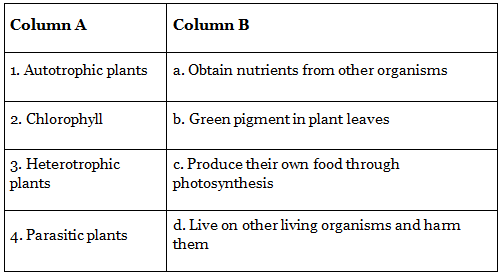Nutrition in Plants Class 6 Worksheet Science Chapter 1
Section A: Multiple Choice Questions
Q. 1. Which of the following is not an autotrophic plant?
a. Algae
b. Moss
c. Mushroom
d. None of the above
Q.2. What is the process of making food by the plants called?
a. Respiration
b. Photosynthesis
c. Transpiration
d. Reproduction
Q.3. Which of the following is not a necessary condition for photosynthesis?
a. Carbon dioxide
b. Water
c. Light
d. Nitrogen
Q.4. Which type of nutrition do plants that feed on other living organisms have?
a. Heterotrophic nutrition
b. Autotrophic nutrition
c. Omnivorous nutrition
d. None of the above
Q.5. Which type of plants obtain their nutrition from dead and decaying matter?
a. Parasitic plants
b. Saprophytic plants
c. Insectivorous plants
d. Symbiotic plants
Section B: Short Questions
Q.1. Define autotrophic nutrition.
Q.2. Write the equation for photosynthesis.
Q.3. Why is photosynthesis important for living organisms on Earth?
Q.4. List the necessary conditions for photosynthesis.5. What is heterotrophic nutrition?
Section C: Fill in the blanks
Q.1. The process by which plants make their own food is called ____________.
Q.2. The pigment responsible for absorbing light in photosynthesis is ____________.
Q.3. Plants absorb ____________ from the air and ____________ from the soil during photosynthesis.
Q.4. ____________ plants obtain their food from other living organisms.
Q.5. The process of photosynthesis takes place in the ____________ of a plant cell.
Section D: Match the column
Match the terms in column A with their descriptions in column B.

Section E: True or False
Q.1. Photosynthesis occurs only in the leaves of the plant. ( )
Q.2. The primary function of chlorophyll is to provide energy for photosynthesis. ( )
Q.3. Heterotrophic plants produce their own food through photosynthesis. ( )
Q.4. Insectivorous plants obtain their nutrients from dead organic matter. ( )
Q.5. Symbiotic plants have a mutually beneficial relationship with other organisms. ( )
You can access the solutions to this worksheet here.
|
139 videos|151 docs|18 tests
|
FAQs on Nutrition in Plants Class 6 Worksheet Science Chapter 1
| 1. What is the process of photosynthesis in plants? |  |
| 2. Why are leaves important for plant nutrition? |  |
| 3. What are the different types of nutrients that plants require? |  |
| 4. How do plants obtain water and minerals from the soil? |  |
| 5. What role do fungi play in plant nutrition? |  |






















